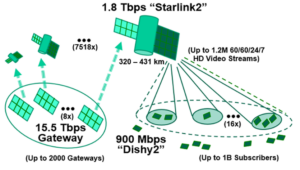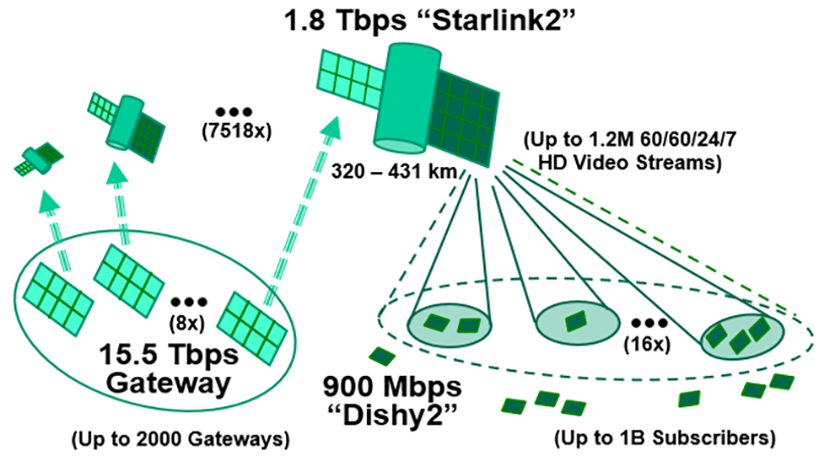This piece describes recently patented Dynamic Polarization Spatial Multiplexing and Beamforming (“Dynamic Polarization”, or “DPSMXBF”) technology and how it could enable so-upgraded Low Earth Orbit satellite (“LEOSat”) networks to close the worldwide Internet Haves versus Have-nots “digital divide” in just a few years.
Two decades into the new millennium a decided preponderance of the planet’s population still lacks good video-quality Internet at home. One might think that all those newfangled LEOSat constellations now starting to launch could together finally mend that particularly 21st century global socioeconomic rift, but not even SpaceX’s full-up Starlink network can even begin trimming back the masses of Netflix-deprived. Its planned 12k 15 Gbps satellites will deliver less than 2M 720p HD streams to the billion-plus households clamoring below, an over 100x Internet capacity shortfall. So, as launching 1.2M satellites likely exceeds the wherewithal of even Elon Musk, one might conclude that the global Internet connectivity chasm will remain un-spanned for some while.
Not so fast. An out-of-the-blue technical breakthrough come of a most unlikely source would infuse powerful terrestrial wireless-derived technology into those emerging LEOSat radios so they could massively rain Internet down from the sky. An honest-to-goodness Eureka Moment visited upon a retired RF engineer (uh, me) two years ago led to my inventing, of all things, a radio antenna that could shotgun modern 21st century (4.8 Gbps WiFi-pedigreed) data rate-multiplying Multiple-Input-Multiple-Output Spatial Multiplexing (“MIMO SMX”) together with early 20th century (and LEOSat-ubiquitous) ultra-long range phased array Directional Beamforming (“DBF”) to boost LEO satellite Internet capacity by orders of magnitude. So that, say, a 128th order Dynamic Polarization-endowed second tranche of 7518 SpaceX 1.8 Tbps “Starlink2” satellites launched around mid-decade could single-handedly overcome the above Internet shortfall and finally, definitively (and tritely), yes, “BtDD”.
Such an audacious claim demands proper substantiation, which I’ll concisely attempt (less too much tech-speak) in the following paragraphs. If your eyes start glazing over nonetheless, skip on down past Figure 4. Otherwise, Figure 1 shows a LEOSat Downlink annotated in the matrix language of MIMO multi-signal processing:
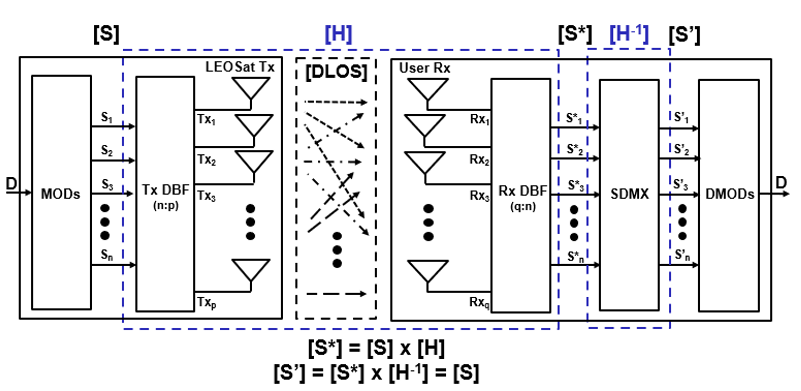
Data D is first modulated into n Tx spatial streams [S]. [S] is then transmit phased array beamformed (Tx DBF), launched wirelessly through the Direct Line of Sight satellite-ground link (DLOS) and receive phased array beamformed (Rx DBF) into n Rx spatial streams [S*], a process collectively represented by the “LEOSat Propagation Channel” [H]. [S*] then gets spatially demultiplexed (SDMX) into an [S’] (purportedly equivalent to the original [S]) for demodulation back into D. Figure 1 also teases the fundamental MIMO spatial multiplexing methodology: Characterize [H] so the SDMX can apply its inverse transfer function [H-1] to recover the propagation channel’s input [S] from its output [S*].
My Eureka Moment begat novel LEOSat Tx/ User Rx antenna structures that ingeniously synthesize a trivially structured [H] that in turn precipitates a trivially implemented [H-1]. The core epiphany was realizing that (conceptually and practically much simpler than it sounds) n-dimensional orthogonal binary sequenced antenna polarization at the signal source can “spatially channelize” an arbitrarily large number n of concurrent, cochannel RF spatial streams traversing a satellite-ground link in a fashion that tremendously simplifies their robust recovery, isolation and reconstitution at the signal destination.
Figure 2 presents the so-synthesized Dynamic Polarization Channel [HDP] incorporating my Eureka Moment “DPA” Tx and Rx antennas, plus a depiction of [HDP]’s specifically enabling “DPC” Dynamic Polarization Codeset, a specially selected set of n distinct spatial stream polarization sequences.
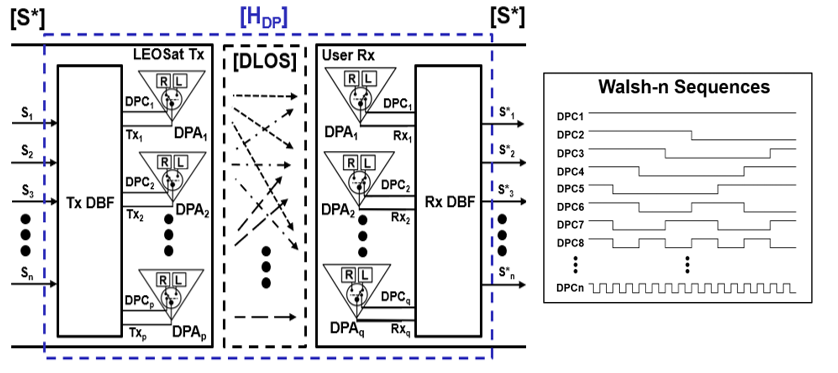
The LEOSat Tx and User Rx employ selectable dual polarization (LHCP/ RHCP) DPA antennas controlled by reciprocally orthogonal binary DPC sequences in order to impress n-dimensional orthogonal polarization on their respective radiated and detected spatial streams. The precise step by step operations are depicted in Figure 3:
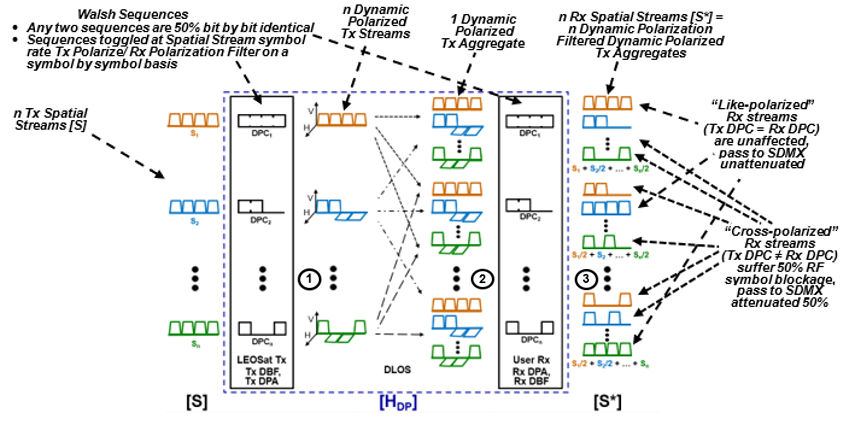
[S] undergoes sequential LEOSat Tx Dynamic Polarization (1), DLOS propagation channel Aggregation (2) and User Rx Dynamic Polarization Filtering (3) upon traversing [HDP] to emerge as [S*]. At the output, each individual spatial stream S*i consists of a single distinct “Tx-Rx like-polarized” Si of reference amplitude “1” plus n-1 other “Tx-Rx cross-polarized” Sj≠I, each of relative amplitude “1/2” (find [HDP] properly expressed in MIMO-speak below). It turns out that such a strikingly simple (i.e., deterministic, uniform and time-invariant) [HDP] transfer function is readily matrix-inverted into a correspondingly simple (ditto) [HDP-1] SDMX, also MIMO-represented in the comprehensive Dynamic Polarization LEOSat Downlink model of Figure 4:
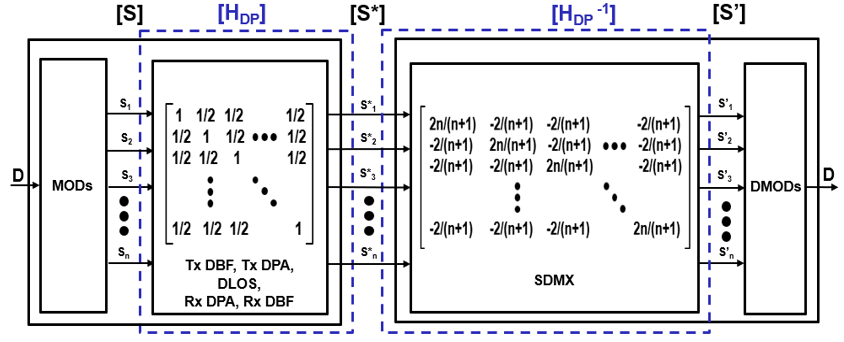
LEOSat radio that by design employs enormous Tx and Rx phased array antennas can thereby exceptionally exploit Dynamic Polarization. A “small” LEOSat Tx DPA array (of, say, 256 antenna elements) used to maximize the Tx spotbeam ground footprint demands a correspondingly large User Rx counterpart (say 1024 elements) to total up to the budgeted link antenna gain. 128th order Dynamic Polarization SMX nicely accommodates both DBF array configurations, while multiplying Internet capacity by 128! At what cost, such a marvel? Well, the transceiver microchips increase significantly in size and cost, making for more expensive (although not that many) LEOSats. However, the corresponding hike in User Rx unit costs will be drowned in the wake of a perhaps 50x boost in volume shipments of such subscriber CPE, not to mention the accompanying 50x jump in monthly Internet subscription billings. IOW, Dynamic Polarization could increase LEOSat Internet distribution capacity over 100-fold at insignificant cost– A VERY BIG DEAL!
So let’s now revisit that grandiloquent notion of dispensing Hi-Def satellite Internet to all those billions still poorly- or un-connected worldwide. Specifically focusing on Starlink’s planned Phase 2 rollout, launching 7518 more LEOSats in itself sounds great but doesn’t really address Earth’s core demographic problem: 95% of its population lives on 10% of its land. Only 2.5% of any globe-blanketing constellation will overfly that particularly peopled landmass at any time, meaning that the effectively 97.5% idle legacy Starlink could only ever beam 1.7M HD streams to those 1.3B Internet-poor households below.
Enter Dynamic Polarization. Let’s first gin up comparative satellite link budgets for the no-SMX legacy Starlink Phase 2 currently in the works and the fanciful DPSMXBF-128-endowed Starlink2. Extrapolation from the very sparse SpaceX technical info available on the Internet gives us Figure 5:

Figure 6 visualizes the Starlink2 model incorporating DPSMXBF-128 radios in mid-decade SpaceX Gateways, LEOSats and CPE.
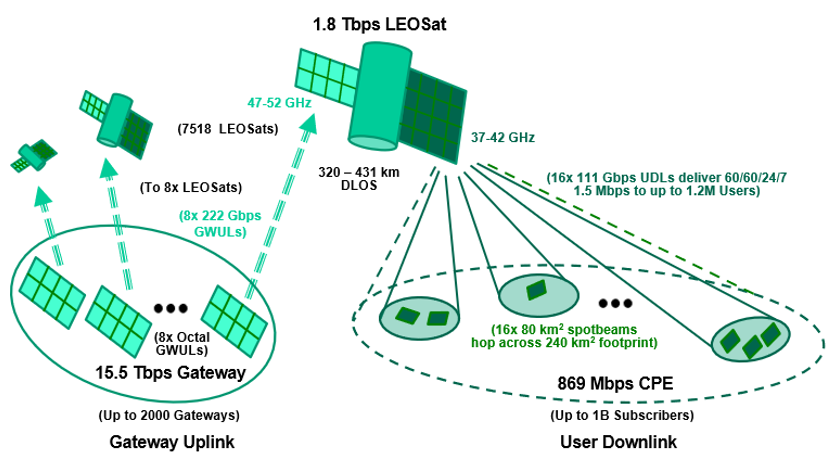
128th order Dynamic Polarization enables one 1.8 Tbps LEOSat to relay Internet uplinked from one 15.5 Tbps Gateway to 16 internal 111 Gbps LEOSat Tx radios, each downlinking within a near quarter-million km2 ground footprint (think 1.2M Netflix streams shoehorned into 16 5 km-wide spotbeams madly hopscotching across an area the size of Wyoming). Starlink2 subscribers worldwide would employ 870 Mbps CPE comprising a single spatial stream (out of the 128) peeled off a 111 Gbps User Rx radio to downlink anytime, all the time minimum 720p HD Internet at home. By 2026 the 2.5% non-idle Starlink2 satellites could be downlinking 334 Tbps (i.e., 223M concurrent Netflix sessions) to those 1.3B potential subscribers below. At an eminently reasonable 6x oversubscription ALL those households could ultimately boast HD Internet from the heavens. And, since Starlink2 radios would differ from the original Starlink transceivers in just chipset innards, delivering Dynamic Polarization Internet to a billion households entails the same capex/ opex as providing legacy LEOSat broadband to SpaceX’s originally targeted 20 million or so. Elon could conceivably charge a global mean of $15/mo ($20 first world, $10 third world?) for Starlink2 Internet, sign up nearly 1B subscribers and more than amply fund his Manned Mars Missions.
Stepping back a bit, figuring that within the decade just about any big city high-rise apartment, suburban flat or rural farm on the planet could sprout a “Dishy McFlatface” and stream You Tube seems a mind-boggling consequence of a solitary Joe Engineer’s dreaming up a new antenna one morning. Let’s rewind back two years to that Eureka Moment. Visions of such sugar plums already starting to dance in my wee little head, I realized that in over 40 years of building radios I’d never come across a need for continuously toggling an antenna’s polarization. Hmm, time to call the patent lawyers. Fast-forward to present day, my hunch was correct, as the USPTO recently issued me the first two in perhaps a series of patents covering DPSMXBF wireless communications.
Now, clever antenna postulating and matrix manipulating (and patents, too) are just swell, but I wasn’t gainfully employed four decades in Silicon Valley just pushing fantastical wireless technology schemes. I actually designed, built, tested and validated 20-odd distinct digital microwave radios in my time, which leaves me now in a bit of a pickle. Several years retired, I’ve no longer access to the megabuck-plus suite of radio system simulation and antenna design tools, prototyping shop, RF lab, microwave test equipment and wireless SoC development system needed to kludge up a reasonable Dynamic Polarization technology demonstrator. Meaning I’m pretty sure DPSMXBF works but I’ve not the wherewithal to prove it. So I’ll gamely need to pass the lead on proper Dynamic Polarization validation to some sufficiently well-resourced entity with more than a passing interest in the technology. I’m on LinkedIn, look me up.



